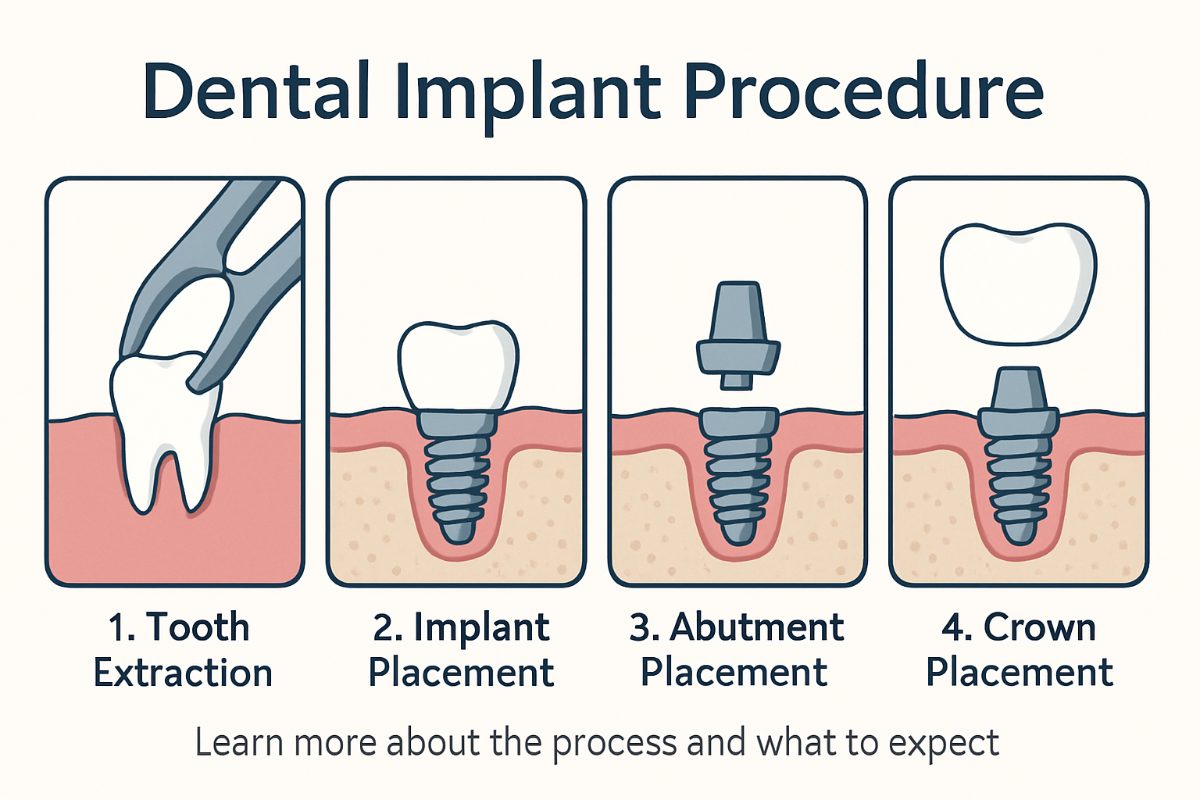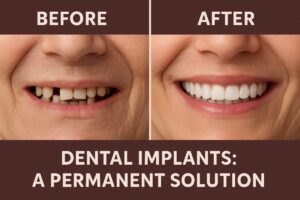This post gives a clear, patient-friendly overview of the step by step dental implant procedure. You’ll learn what to expect at each stage, how long healing usually takes, common symptoms, and when to call your dentist. The goal is to reassure you that implants are a well-established option with predictable outcomes and to help you prepare for each visit.
What Is A Dental Implant?
A dental implant is a titanium screw placed into the jawbone that acts like a tooth root. The three basic parts are the implant (the metal post), the abutment (the connector), and the crown (the visible tooth). Typical candidates are adults with one or more missing teeth, good overall health, and enough bone—or who are willing to have bone grafting if needed.
Step By Step Dental Implant Procedure
1) Consultation & Treatment Planning
First you’ll have an exam, X-rays or 3D imaging, and a medical history review. The dentist will check oral health, discuss goals, and plan whether any teeth need extraction first. You’ll get a written timeline and estimate for the full treatment.
2) Implant Placement Surgery
During implant placement, the dentist or surgeon makes a small opening in the gum, places the implant into the bone, and closes the site. Local anesthesia is common; sedation options are available for nervous patients. One implant typically takes 30–90 minutes; full-arch cases take longer.
3) Healing & Osseointegration (2–6 months)
Over weeks to months the bone grows around the implant in a process called osseointegration. You’ll have follow-up visits to check healing. Many patients wear a temporary crown or denture while the implant bonds to the bone.
4) Abutment Placement & Final Crown
After integration, the dentist attaches the abutment and takes impressions or digital scans. The lab makes the permanent crown, which is then placed and adjusted for fit and bite. This completes the restoration.
Variations To Expect
- Immediate-load (same-day) implants that get a temporary tooth right away.
- Bone grafts or sinus lifts when bone is insufficient.
- Single-tooth implants, multiple implants, or full-arch solutions like implant-supported dentures.
Recovery Timeline, Pain Management & Risks
Most patients recover steadily. The first 48–72 hours usually bring the most discomfort and swelling. By the first week pain and swelling often decrease a lot. Full bone healing and final restoration can take 2–6 months depending on the case.
Pain, Swelling & Home Care
Expect mild-to-moderate pain and swelling the first few days—over-the-counter pain relievers or prescription meds can help. Use ice packs the first 24–48 hours, eat soft foods, and avoid smoking. Keep the area clean with gentle rinses (salt water) and follow your dentist’s brushing instructions.
Potential Complications & When To Call
Most implants succeed, but watch for red flags: fever, heavy or increasing bleeding, severe or worsening pain after the first few days, pus or drainage, numbness that does not improve, or a loose implant. Contact your dentist right away if you notice any of these signs.
Questions To Ask Your Dentist & Next Steps
- How many implant cases do you perform each year?
- What are your success rates and complication rates?
- Will you use 3D imaging or guided surgery for my case?
- What anesthesia and pain control options do you offer?
- What is the full estimated cost, and are financing or warranties available?
- What is the expected timeline from start to finish?
Our practice uses digital treatment planning and clear timelines to help patients feel confident about their care. If you’re ready to learn whether implants are right for you, call us to schedule a consultation and get a personalized plan.






